
How to Take Care of a New Pet

Getting a new pet means welcoming huge responsibility into your home which is why it’s essential to be prepared. We at 5-Minute Crafts have a simple and easy-to-follow guide that will give your pet a comfortable welcome and make the adjustment easier for you too.
How to take care of a new dog
What to get for your dog:
- Pee pads that won’t tear or leak
- Dog-approved toys
- Sturdy dog crate
- Doorway gate
- Food and water bowls
- Food
- Dog nail clippers and brush
- Comfy bed
- Leash
- Travel harness or pet carrier
- Collar
- Cleaning supplies
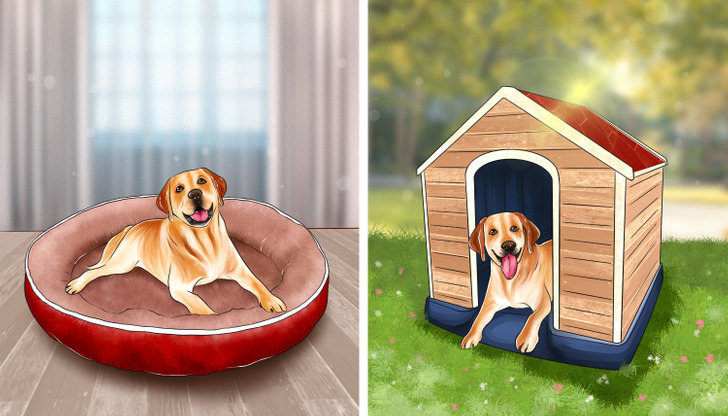
- Provide your dog with a shelter: one that will protect it from hazards and the elements, whether it’s an outside warm and comfortable dog house or its own bed for the inside.
- Make sure you get bowls for both food and water: Hydration is important for energy and health.
- Feed your dog a quality diet: Too much weight on a dog, just like a human, can have negative health side effects. The best way to determine your dog’s nutritional needs is to talk to your veterinarian. And depending on your dog’s age, size, breed, and level of activity they will instruct you on feeding it.
- Visit the veterinarian regularly: Your veterinarian will give you information about external parasites and deworming as well as vaccination schedules. And make sure you keep a copy of their vaccination records at home and with you when you travel together. If you notice a change in your dog’s behavior or that it seems injured or ill don’t take things into your own hands but take it to the vet and work together as a team to get your dog back on its paws.

- Provide your dog with good exercise: All dogs are different and they each might need a different amount of exercise. Finding out what they need will help them to stay fit and healthy. And being in shape will allow them to enjoy their activities more.
- Talk to your dog: Almost all dogs enjoy social activities so they need to interact with the people around them. Quality time will not only help you understand it better but also prevent many undesirable behavioral patterns. Plus you will be able to tell in a timely manner if they are showing signs of illness and you’ll be able to help in time.
- Train your dog: This doesn’t mean making them a professional dog but teaching them simple commands because this will provide a chance for them to live a long and safe life. If you can’t do it yourself you can search for training classes that can help you out.
- Feeding your dog: It’s important to provide your dog with good nutrition. Store-bought dry and wet food is good, but you can always consider preparing them homemade food. If you do so, make sure you balance it well: 50% veggies, 40% protein, and 10% starch.
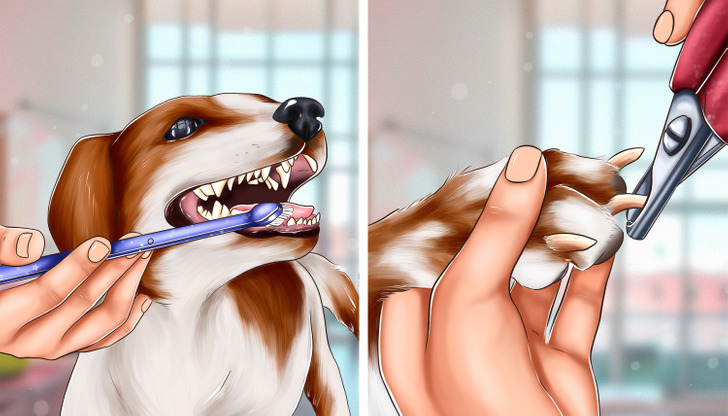
- Don’t forget about dental care: Just like humans, dogs need dental care and there are even breeds that are more prone to diseases of the gums that can lead to serious implications.
- Nail trimming and grooming: This is not just about looking good. For example, long-coated dogs have a higher chance of develop ice balls and mats in their fur. Overgrown nails, especially in elderly dogs, can make it more difficult for them to walk. Plus, long nails are prone to breaking, and this can be painful. However, make sure to be careful when trimming their nails because it can easily hurt them.
- Think about reproductive control: If you don’t want to breed your dog and have puppies neutering or spaying is always an option. Just make sure you consult with your vet about the options available.
- Puppies can sleep up to 20 hours per day: You might even notice them falling asleep in the middle of a game. It’s important to not disturb them and to try to make a sleeping schedule that will also suit you so that you can have a good night’s sleep as well.
How to take care of a new cat
What you need for your new cat:
- Crate or carrier
- Food
- Food and water bowls
- Litter box and litter
- Bed
- Scratching post
- Toys

- Give your cat a place to hide: New cats are, most of the time, nervous and they try to hide. Sheets placed over chairs or cardboard boxes are the best hiding spots for your new cat. If the cat is shy, it’s advised to remove any big furniture like dressers and beds. It’s easier to connect with a cat that it’s hiding in a box and not inside a dresser or under a bed.
- Give your cat safe and quiet time: Prepare a safe, starter room where your cat will have the time to become familiar with the sounds and scents of your home. This room must have a secured door.
- Cat-proof the room: Remove any breakable items, put the cat’s toys in a safe place, and keep plastic bags away from them because they enjoy playing with them but they can easily suffocate. Remove curtain and venetian cords, and put away any electrical cords.
- Look out for poisonous plants: There are plants that can be toxic to cats and cause inflammation to the stomach, mouth, skin, etc., and even damage their organs. So make sure you remove the following plants: Sago Palm, Yew, Tulip, Devil’s Ivy, Spanish Thyme, Peace Lily, Oleander, Lily of the Valley, Lily, Hyacinth, Kalanchoe, English Ivy, Daffodils, Dieffenbachia, Castor Bean, Cyclamen, Amaryllis, Azaleas and Rhododendrons, Chrysanthemum, Daisy, Mum, and Autumn Crocus.
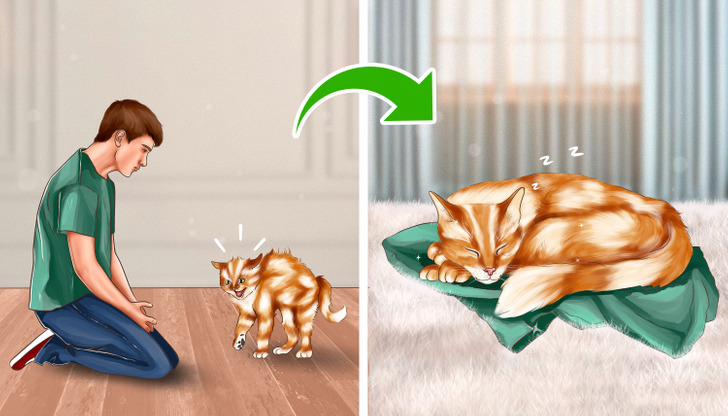
- Use your worn shirt: One trick that might help your cat get used to you is to place your t-shirt in the safe room so that it can get familiar with your scent.
- Provide nutrition and litter: Place bowls with water and food on one side of the room, and on the other a litter box. If your cat is shy they might not eat in their first 24-48 hours and could have diarrhea from all the anxiety and stress. But if the cat is persistent and hasn’t eaten anything after 48 hours, try other tasty treats. If you still can’t get it to eat it’s better to consult with your vet.
- Feeding your cat: It’s not that easy to make homemade food for cats because you might not be able to provide it with the right stuff. That’s why canned/wet and dry food are recommended. Both are beneficial and you can feed your cat whatever it prefers or maybe even a combination of both.
- Don’t forget about a scratching post: Place one inside the safe room because scratching is actually a comforting and natural behavior for any cat. Plus, it’s essential that the post is new and hasn’t been used by another cat. Your new companion won’t like to be stressed by the smell of the other cats while it’s adapting to its new home.
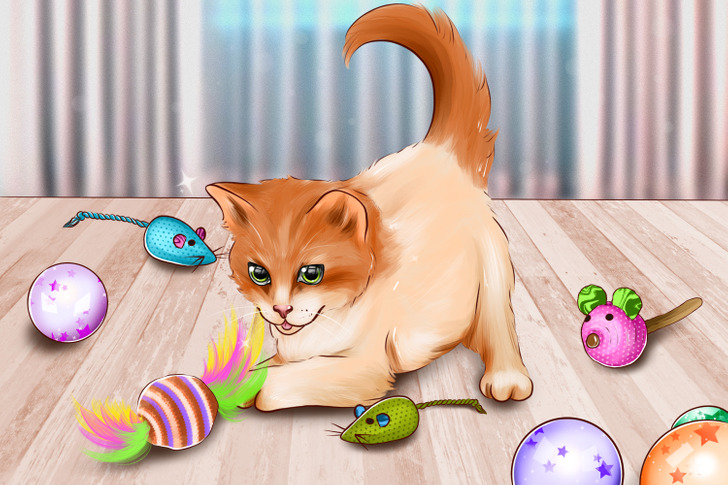
- Get some cat toys: This will provide them with entertainment, especially when you are not around. It can be anything, from toy mice to balls.
- Spend some quality time together: There are a few ways you can spend some time with your new friend, depending on how shy they are. You can either play with them or pet them or you can just sit in the same space while reading a book or just chatting on your phone. Remember that nervous cats might twitch their tail, hiss, growl, or put their ears back. The best way to respond to this is by speaking softly and giving them some space and time alone.
- Out from the safe room: Once your cat establishes a trusting relationship it can start exploring your home. However, make sure that you are at home during this process so that you can supervise. Make sure to close most of the doors, especially because too many new places can frighten and stress the cat. If your cat is shy, make sure to not let it in the basement. This is because basements have many different hiding places and some aren’t even accessible to humans.
- It’s time to let it explore: Keep in mind that there are different personalities and your cat might need just 2-4 days to feel safe while others may need 2 weeks or more. Be patient.
Tip: Little kittens are known to sleep for 22 hours daily. Even a 6-month-old kitten could sleep up to 20 hours per day. Make sure it’s comfortable and undisturbed.
How to take care of a guinea pig
What you need for your new guinea pig:
- Solid-bottom cage (at least 24×12×12 inches)
- Water bottle
- Hayrack
- Food bowl
- Chew toys
- A hide house
- Pine, aspen, or recycled paper bedding (don’t use cedar — it’s toxic for them!)
- Oat grass, orchard grass, or Timothy hay

- Give your guinea pig some space: They do love to cuddle but not on the first day, give it time to adjust and settle in.
- Talk to it: Speak to them with soothing soft tones and give them gentle strokes to their head. If it’s still shy give it more time.
- Prepare the habitat: Make sure to stock the living space with treats and toys, and make sure it’s in a cool spot and away from larger pets. Plus keep it away from drafty windows so that their body temperature can be regulated.
- Put its hay food on a rack: The feeding hay looks like the hay used for bedding, and you probably don’t want your new furry friend to dine on its mattress.
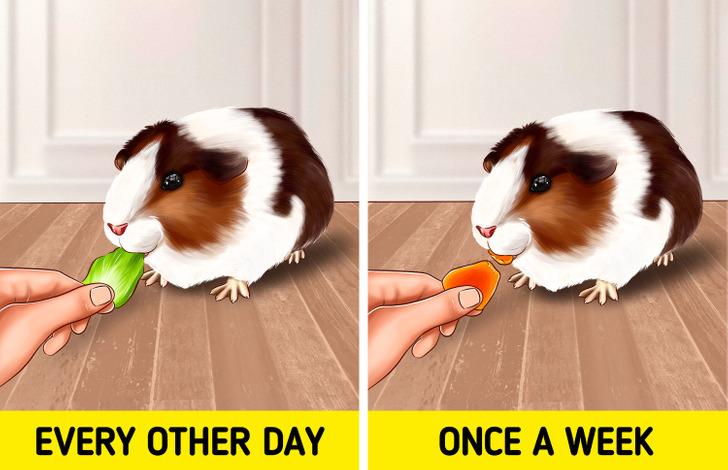
- Feed it salad too: Every day, fill the food rack with fresh hay but every other day give it some salad like shredded carrots, zucchini, collard greens, or kale. Once a week give them a fruity snack like mango, banana, or papaya. 2 times a week give it alfalfa and raisins.
- Remember the diet ratio: A healthy diet for a guinea pig means 20% veggies and 5% fruit and the rest is hay.
- Cleaning the habitat: Change their bedding every month and clean their bowl of food if it’s been sitting for more than 4 hours. Also, add clean water daily.
- Play with them: Guinea pigs love playing, especially if it involves foraging, and this means getting them toys that you can hide treats in. Also, if you plan to let them outside their habitat make sure to keep an eye on them so that they don’t chew on something dangerous.
Tip: Guinea pigs are very active animals and they don’t spend a lot of time sleeping. They sleep about 9 hours over a 24-hour cycle.
Check out these genius hacks for smart pet owners
Share This Article